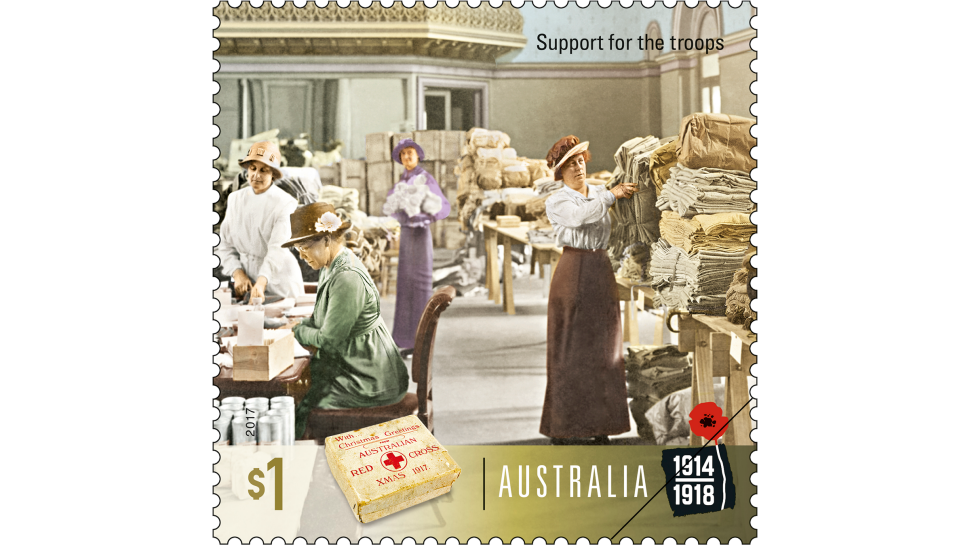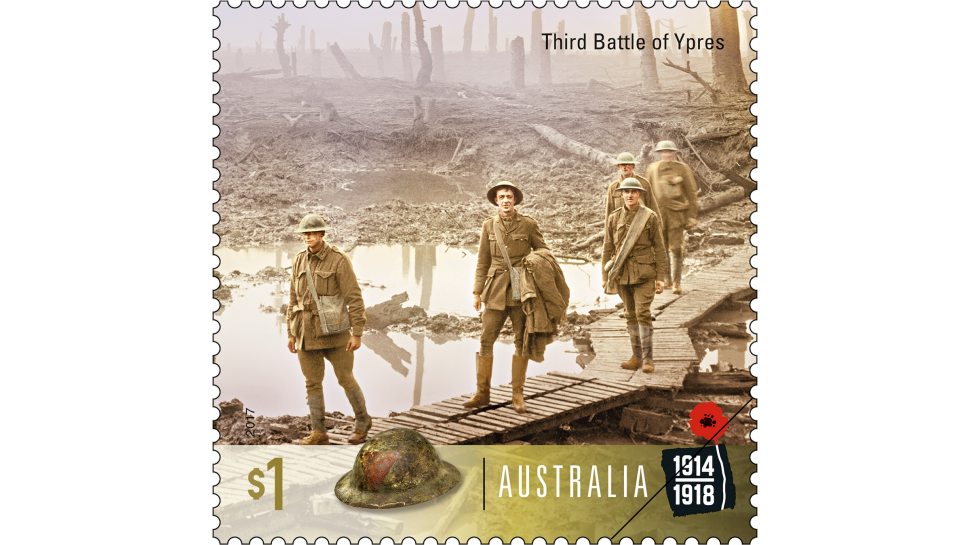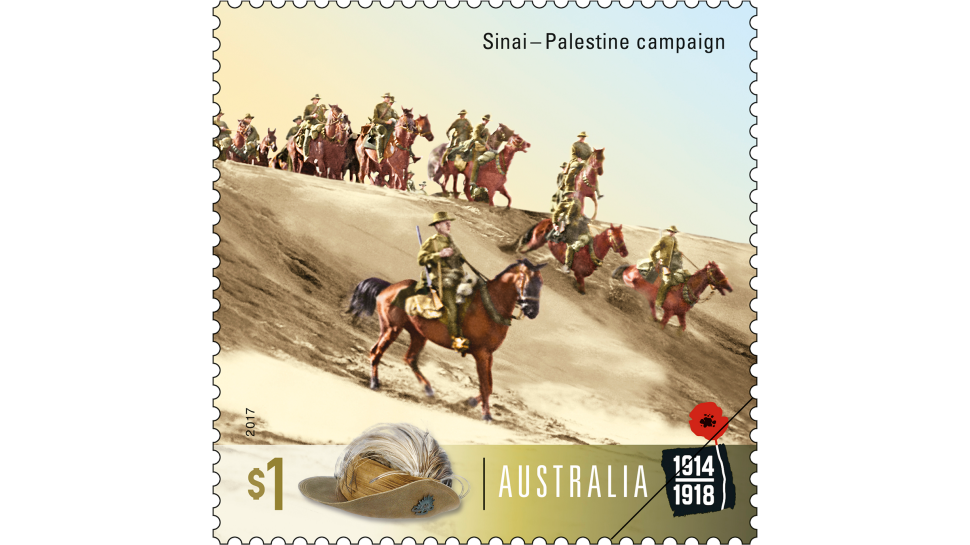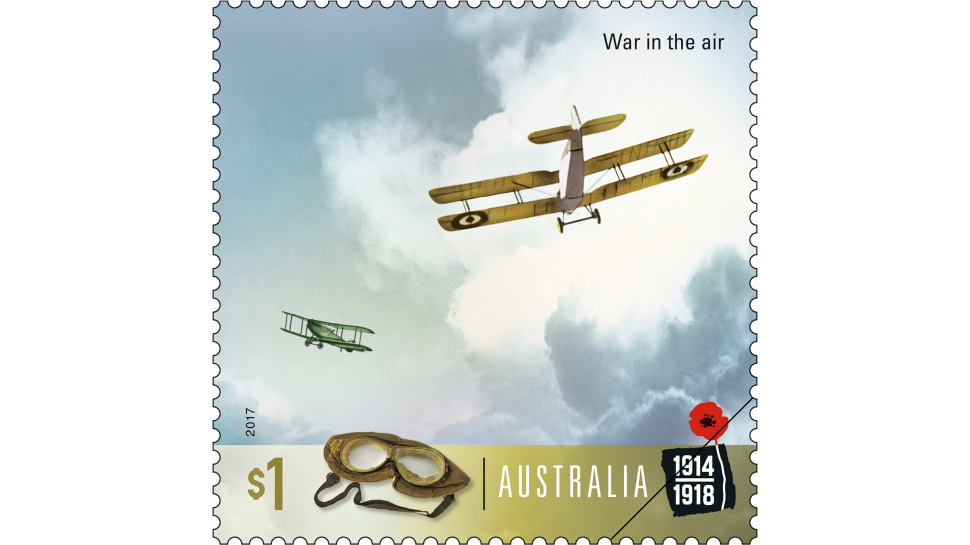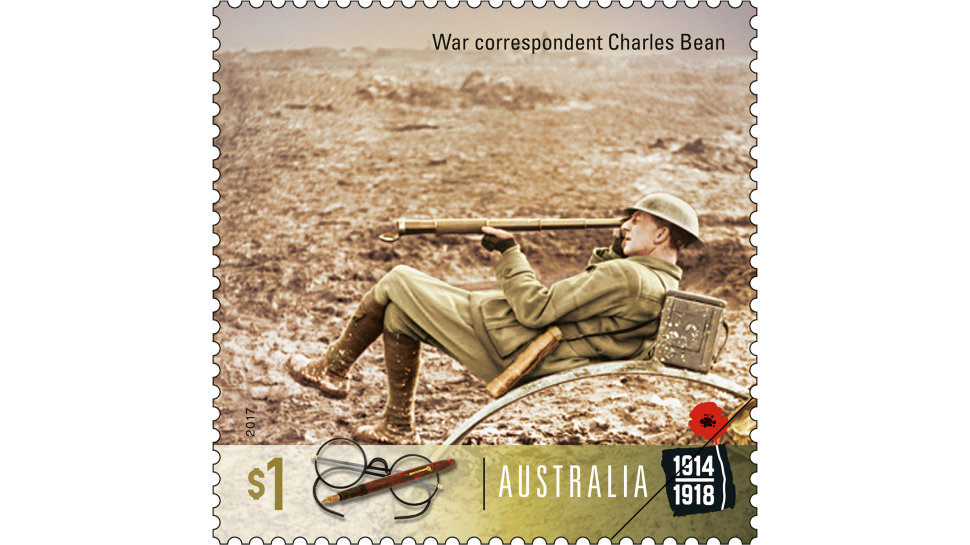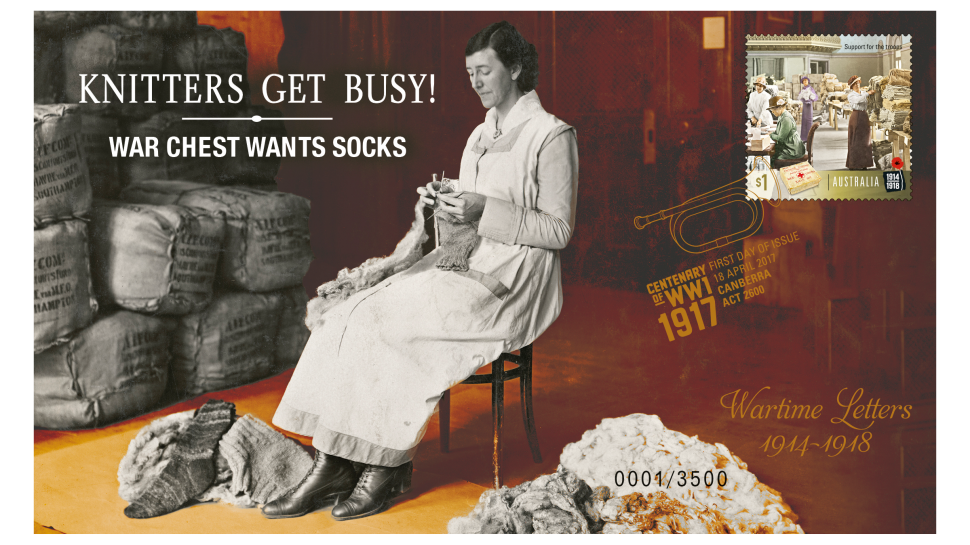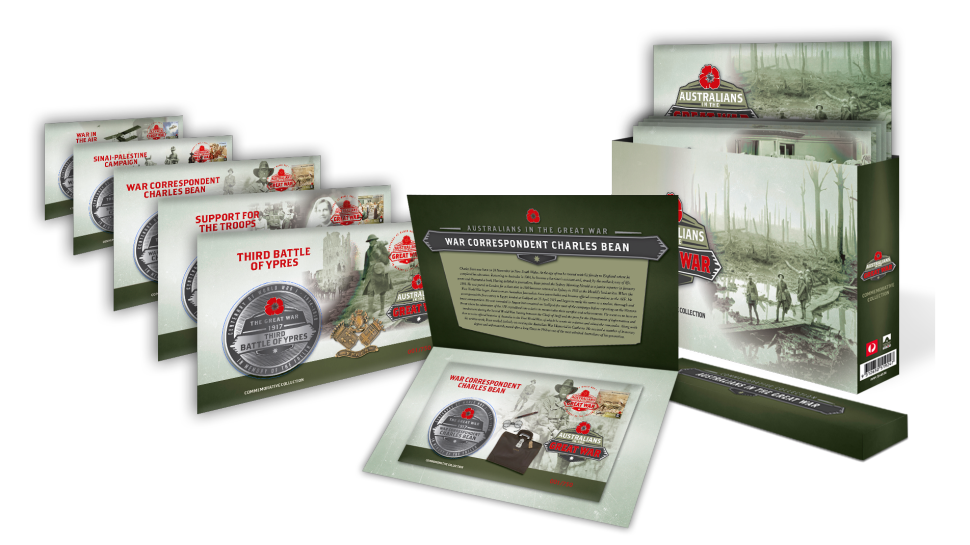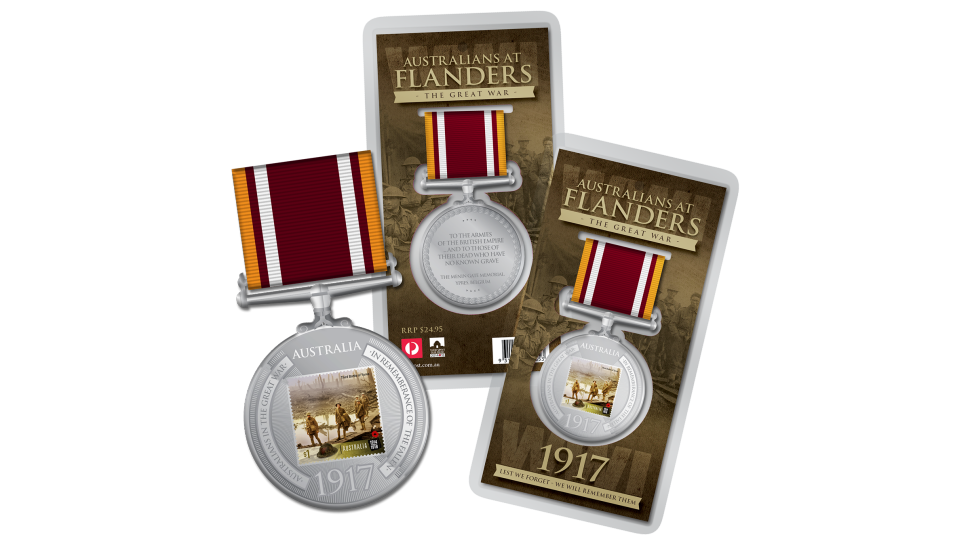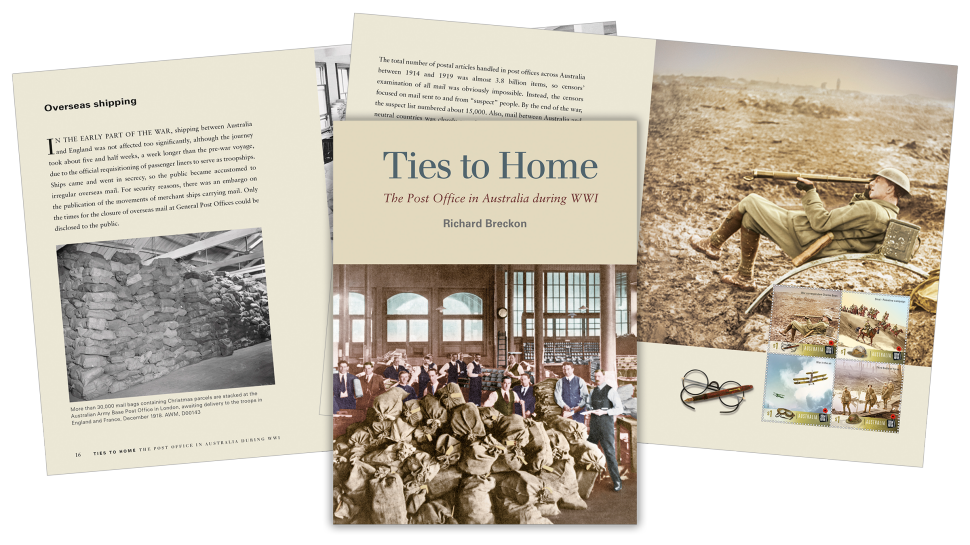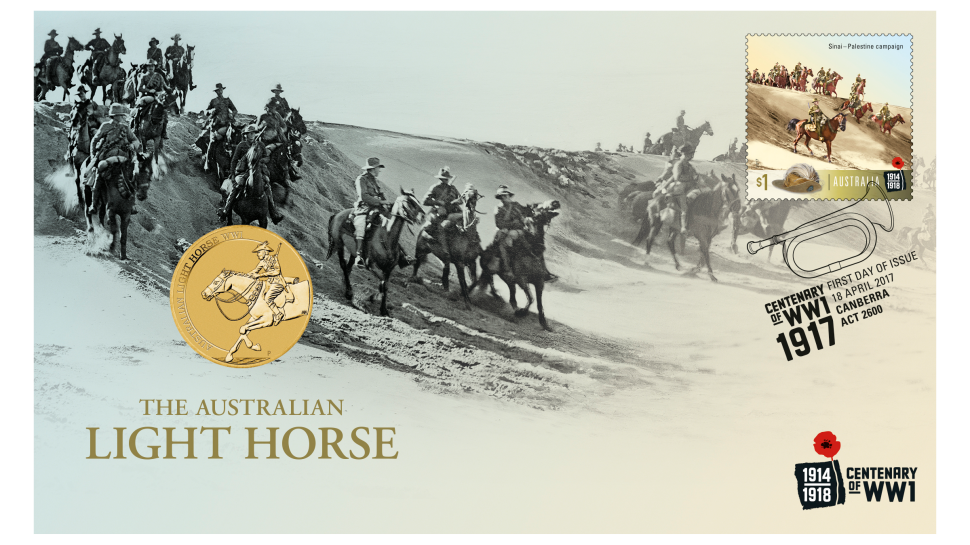By the end of 1916, some 40,000 Australian soldiers had been killed or wounded on the Western Front, but this number was nearly doubled by the end of 1917: some 76,836 Australian casualties in fact.
The fourth in our five-part series commemorating the centenary of World War I will be released on 18 April 2017. These five domestic base-rate stamps, designed by Phil Ellett of Creative Ethos, explore key themes and events of 1917, using photographs from the Australian War Memorial collection.
The European winter of 1916–17 was the worst in decades. The autumn that followed brought even more rain, and battlefields became virtually impassable lakes of mud. “Trench foot”, frostbite, exhaustion and shell shock all took their toll. Duckboards helped troops cross landscapes decimated by artillery and submerged in water; 65,000 sheepskin jackets were sent from Australia to keep the men warm; and soldiers were issued with additional woollen socks, many knitted by volunteers on the home front, and instructed to change them at least twice daily to help stop outbreaks of fungal trench foot.
In the stamp above, women volunteers are shown in the Ballroom at Federal Government House in St Kilda Road, Melbourne, which was used by the Red Cross for the storage of goods sent in by local branches. They are sorting and packing items to be sent in parcels to troops overseas. This was the location of the state headquarters of the Australian Red Cross, which formed in 1914, for some of the war years. Besides the Red Cross, many other local organisations and groups provided support for troops at the front, and for returned soldiers.
A primary aim for allied forces in 1917 was to occupy Flanders and remove the Germans from the Belgian coastline. In an attempt to break out of the so-called Ypres Salient, British forces first had to occupy the Messines ridge at the region’s southern end. In this well-planned offensive in early June, 19 underground mines were simultaneously detonated beneath the German positions in what was then the largest man-made explosion in history. The German positions were swiftly captured, but not without significant casualties.
Soon after, between July and November 1917, the Australians fought a series of actions in an offensive that became known as the Third Battle of Ypres. Although costly in casualties (38,000 Australian troops died), the actions fought by the Australians were highly successful in capturing the ground they sought. Fierce battles waged at Menin Road, Polygon Wood and Broodseinde were well supported by massive amounts of artillery that aided the infantry in their attacks. By the time the Australians reached the village of Passchendaele, the low-lying terrain torn up by weeks of shellfire had turned into a morass, making it difficult to bring the guns forward. Autumn rains set in and, along with the stubborn German defence, conditions became untenable. After two attempts to capture Passchendaele, the exhausted Australians eventually handed over to Canadian troops.
Taken by Frank Hurley, the photograph in this stamp shows five Australian members of a field artillery brigade, passing along a duckboard track over mud and water among gaunt bare tree trunks in the devastated Chateau Wood, a portion of one of the battlegrounds in the Ypres salient.
Meanwhile, the campaign against the Ottoman Empire continued in the Middle East. The reorganisation of Anzacs after withdrawal from Gallipoli saw not only the redirection of troops to the Western Front but also the formation of the ANZAC Mounted Division, comprising three brigades of Australian Light Horse, the New Zealand Mounted Rifles as well as the Imperial Camel Corps. In total, five brigades of Light Horse served during the war. In 1916 and early 1917, they secured the Suez Canal and fought at Romani in the Sinai Desert. In 1917, they participated in the advance into Palestine, where they fought actions at Gaza, Beersheba and Jerusalem. In 1918, they moved into the Jordan Valley, where they fought at Jericho, Amman and Es Salt, and ultimately entered Damascus later in the year.
The conditions the Middle East could be no different to those experienced in Europe; in place of bone-chilling cold and lakes of mud, mounted troops endured extreme heat, water shortages and seas of sand. Their casualties, too, in contrast to the Western Front, were comparatively low.
This stamp’s key photograph by Frank Hurley shows the 2nd Light Horse Brigade passing over sand hills at Esdud, on the Philistine Plain.
At the outbreak of the war, aerial technology was still in its infancy and Australia did not have its own air force. It was, however, the only British dominion to contribute a flying corps. Over the course of the war, the Australian Flying Corps (AFC) sent four squadrons to support British operations during the war: Early in the war, a small number of pilots and air mechanics were sent to Mesopotamia, where they flew in support of the British Indian Army in that theatre. No. 1 Squadron flew in the Middle East from March 1916, and Nos 2, 3 and 4 Squadrons served in France for the first time from late 1917. A number of Australian pilots were trained in Britain for service on the Western Front.
In 1914, CEW (Charles) Bean won the Australian Associated Press ballot to become Australia’s official war correspondent, departing for the war in November 1914 with the first contingent of the Australian Imperial Force. The war would come to dominate Bean’s career and life: as well as writing dispatches from the front, he wrote the multi-volume official history of Australia’s part in WWI, he initiated the Australia’s WWI collection, and he conceived of the Australian War Memorial as place to house our national military heritage. During WWII, he again served through his writing, also working in media liaison for the Department of Information.
Herbert Baldwin photographed Bean as he watched the Australian advance through a telescope near Martinpuich, France. The photograph, featured on the stamp, was taken on 26 February 1917.
Historical collectables
An attractive range of collectable products are being released with the Centenary of WWI:1917 stamp issue, including the following:
Prestige Cover (limited to 3,500)
This prestige cover showcases the incredible effort by women on the home front, who knitted thousands of pairs of woollen socks that were sent to soldiers on the Western Front. It is part of the Wartime Letters 1914–1918 prestige cover range and is limited to 3,500.
Box Medallion Collection (limited to 750)
This impressive collection includes exclusive medallions and covers for each of the five stamps in the Centenary of WWI: 1917 stamp issue, each with a red foil postmark. Note: this product is not part of standing orders and must be ordered separately.
Stamp medal
Featuring the Third Battle of Ypres stamp, this attractive medal honours the troops who fought in the Battle of Flanders.
Prestige booklet
The importance of postal services during the war was demonstrated by the ever-increasing quantities of mail exchanged between the home front and front line. The arrival of letters was the ultimate morale booster for soldiers and families and friends at home. This third booklet in the Ties to Home series focuses on the Post Office and mail services in Australia during wartime.
Covers spanning many themes
The stamp issue includes a limited edition Western Front postal numismatic cover (PNC) from the Perth Mint, featuring an Australian Light Horse coin; a limited edition Third Battle of Ypres medallion cover from the Perth Mint; and a limited edition ANZAC PNC from the Royal Australian Mint.
The Centenary of World War I: 1917 stamp issue is available from 18 April 2017, online, at participating Post Offices and via mail order on 1800 331 794, while stocks last.
View the gallery of stamps and technical details for this issue.
This article was produced at the time of publication and will not be updated.

